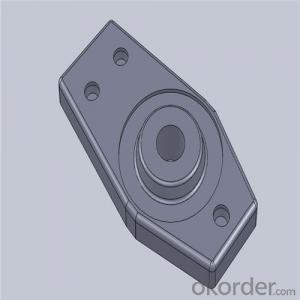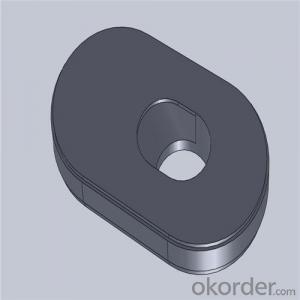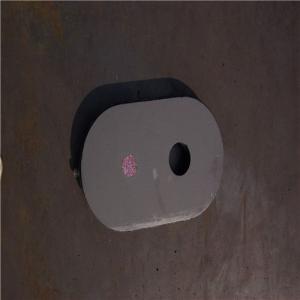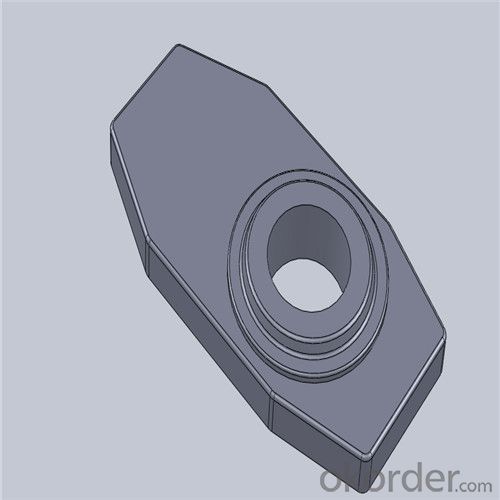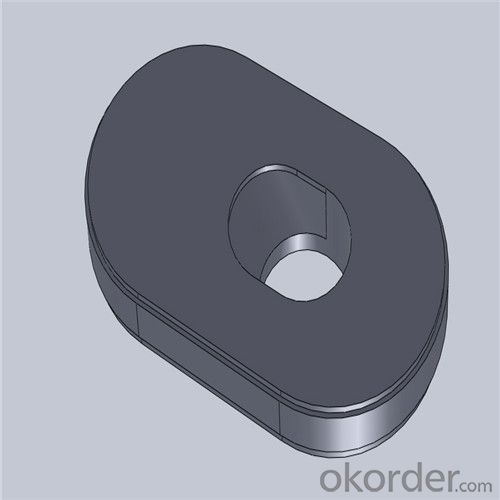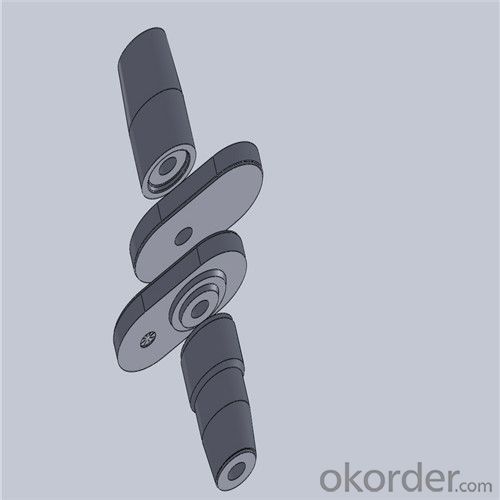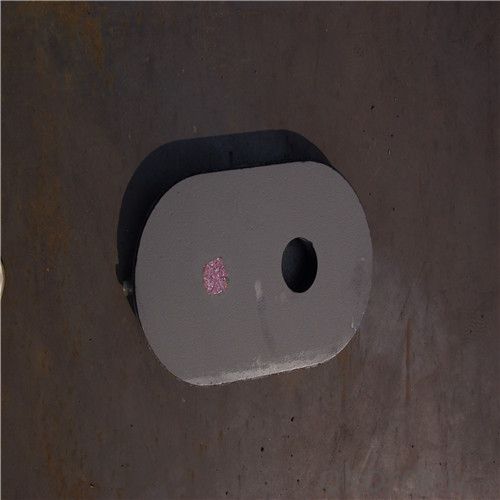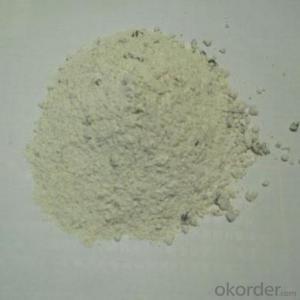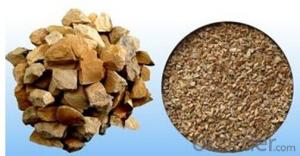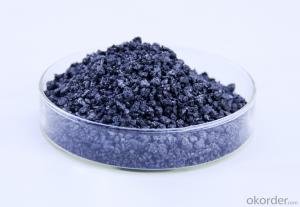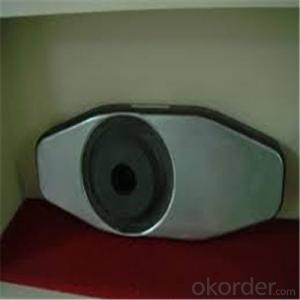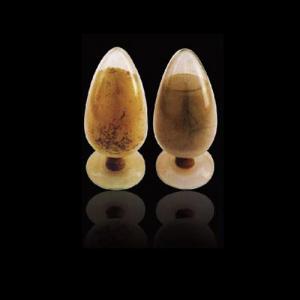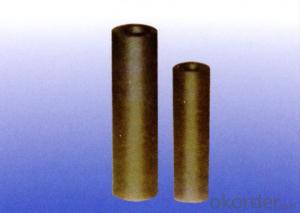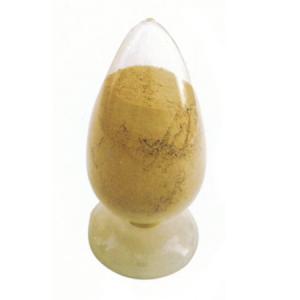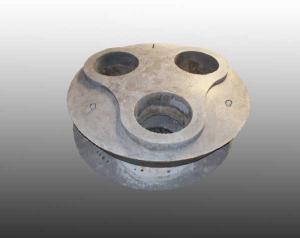Monolithic Refractories High Performance Ladle Sliding Gate for Steel Industry
- Loading Port:
- Shanghai
- Payment Terms:
- TT OR LC
- Min Order Qty:
- 100 pc
- Supply Capability:
- 1000 pc/month
OKorder Service Pledge
OKorder Financial Service
You Might Also Like
Quick Details for High Performance Refractory Ladle Slide Gate
| Place of Origin: | China (Mainland) | Shape: | Plate | Material: | Alumina Block |
| SiO2 Content (%): | N/A | Al2O3 Content (%): | 80-90% | MgO Content (%): | N/A |
| CaO Content (%): | N/A | Refractoriness (Degree): | 1770°< Refractoriness< 2000° | CrO Content (%): | N/A |
| SiC Content (%): | N/A | Model Number: | CS80 | Brand Name: | |
| Product name: | High performance refractory ladle slide gate | Model No.: | cs80 | Brand name: | CMAX |
| Quality: | Al-C or Al-Zr-C | Service life: | 4-6 heats | Apparent porosity: | 7% Max |
| Bulk density:: | 3.1 MIN | C.C.S: | 120MPA | MOQ: | 100 pcs for trial |
| Delivery time: | 60 working days upon receipt of deposit |
Packaging & Delivery
| Packaging Details: | Inner carton packing, outer wooden case suitable for long term sea shipping |
| Delivery Detail: | three months working days upon receipt of deposit |
Specifications
Surface flatness less than 0.05mm
High mechanical strength
Erosion resistance
Oxidation resistance
Thermal shock stability
Using the raw materials of tabular alumina, zirconia-corundum, carbon and other high-grade additives, after sintering to obtain characteristics of oxidation resistance, scour strength, erosion resistance, thermal shock resistance, shape stable and long service life, made our products the preferred materials for the large and medium-sized steel ladle, refining ladle, series of alloy steel ladle, and tundish. Our high performance sintering sliding gates include alumina carbon , Al2O3-ZrO2-C, etc, can meet the needs of different steel grade.
General Chemical Analysis for refractory ladle slide gate :
slide gate plate widely including Alumina carbon and Alumina Zirconia Carbon slide gate plate, MgO and MgO-spinel slide gate plate,nonoxides bonding slide gate plateand unburned slide gate plate.
Alumina -Zirconia-Carbon material
| Al-Zr-C Material | |||||
| Al2O3 | C | ZrO2 | Apparent porosity | Bulk density | C.C.S |
| (% minm) | (% minm) | (% minm) | (% max) | (gm./cc minm) | (MPa minm) |
| 85 | 3 | 5 | 7 | 3.1 | 120 |
| 85 | 3 | 4 | 7 | 3.1 | 120 |
Composite type: Al-Zr-C for working line, outer Al-C material
| Al-Zr-C & Al-C Material | ||||||
| Al2O3 | C | ZrO2 | Apparent porosity | Bulk density | C.C.S | |
| (% minm) | (% minm) | (% minm) | (% max) | (gm./cc minm) | (MPa minm) | |
| Inner side (Working face) | 85 | 3 | 4 | 7 | 3.1 | 120 |
| Outside | 90 | 3 | 0 | 9 | 3 | |
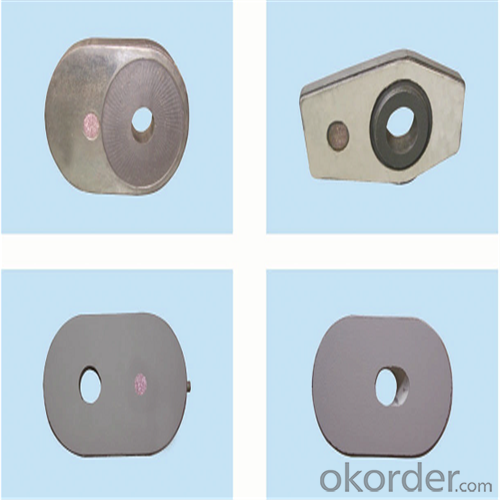

About us


Sample is on your request.
Welcome to visit our factory~
- Q: In iron and steel industry, the main raw materials for blast furnace ironmaking are iron ore, coke and limestone. What's the use of limestone here?
- CaCO3 CaO + CO2 =C = 2CO + CO2Fe2O3
- Q: How do monolithic refractories contribute to the overall efficiency of ladle slagging operations?
- Monolithic refractories play a vital role in enhancing the overall efficiency of ladle slagging operations, which involve removing impurities from molten metal in a ladle before pouring it into molds or further processing. One of the primary benefits of monolithic refractories is their capacity to withstand high temperatures, a crucial factor in ladle slagging operations. The refractory lining in the ladle must endure the intense heat generated by the molten metal and slag, as well as the chemical reactions occurring during the process. By possessing high thermal stability, monolithic refractories prevent the lining from cracking or deteriorating, thus ensuring the integrity of the ladle and maintaining its efficiency. Furthermore, monolithic refractories offer excellent resistance against chemical erosion and corrosion. In the ladle slagging process, the molten metal and slag may contain impurities and aggressive chemicals such as sulfur, phosphorus, and other oxides. These substances can attack and degrade the lining of the ladle, compromising its efficiency. However, monolithic refractories are specifically designed to withstand these chemical attacks, thereby prolonging the lifespan of the ladle and reducing the need for frequent repairs or replacements. Moreover, monolithic refractories possess exceptional thermal insulation properties. Precise temperature control is essential in ladle slagging operations to facilitate desired chemical reactions and efficient impurity removal. The thermal insulation provided by monolithic refractories helps maintain a consistent temperature within the ladle, preventing heat loss and facilitating optimal slagging conditions. Additionally, this insulation minimizes energy consumption and improves the overall energy efficiency of the ladle slagging process. In conclusion, monolithic refractories make significant contributions to the overall efficiency of ladle slagging operations. Their ability to endure high temperatures, resist chemical erosion, and provide thermal insulation ensures the integrity and longevity of the ladle. By reducing the need for frequent repairs and enabling precise temperature control, monolithic refractories optimize the slagging process, leading to enhanced productivity and cost-effectiveness.
- Q: How do monolithic refractories perform in rotary kiln applications?
- Monolithic refractories perform exceptionally well in rotary kiln applications due to their high thermal shock resistance, excellent chemical resistance, and superior strength at high temperatures. Their ability to withstand extreme heat and harsh chemical environments makes them ideal for lining the interior of rotary kilns. Additionally, monolithic refractories offer easy installation and maintenance, ensuring efficient and reliable kiln operations.
- Q: What are the considerations for selecting monolithic refractories for ladles and tundishes?
- Some considerations for selecting monolithic refractories for ladles and tundishes include the specific temperature requirements, chemical composition of the molten metal, thermal shock resistance, erosion and corrosion resistance, mechanical strength, ease of installation and maintenance, and cost-effectiveness.
- Q: What are the typical applications of monolithic refractories in the iron and steel industry?
- Monolithic refractories find several typical applications in the iron and steel industry. These include lining electric arc furnaces, ladles, tundishes, and various other equipment used in the production of iron and steel. Monolithic refractories are also commonly used for repairing and maintaining the linings of these equipment. Their high thermal conductivity, excellent resistance to thermal shock, and ability to withstand extreme temperatures make them ideal for these applications in the iron and steel industry.
- Q: How do monolithic refractories enhance the performance of ladle and tundish preheating systems?
- Monolithic refractories enhance the performance of ladle and tundish preheating systems by providing excellent thermal insulation, high mechanical strength, and resistance to corrosion and erosion. This allows for efficient heat retention and distribution, ensuring uniform and consistent preheating of ladles and tundishes. Additionally, monolithic refractories minimize heat losses, reduce energy consumption, and increase the lifespan of the preheating systems, contributing to improved overall performance.
- Q: What are the key innovations in monolithic refractories for the iron and steel industry?
- Some key innovations in monolithic refractories for the iron and steel industry include the development of advanced materials such as low cement castables, gunning mixes, and shotcretes. These materials offer improved resistance to thermal shock, increased strength, and enhanced erosion resistance, thereby extending the service life of refractory linings in high-temperature environments. Additionally, the introduction of monolithic refractory installation techniques such as robotic application and advanced spraying technologies has improved efficiency and reduced downtime during maintenance and repair operations.
- Q: How do monolithic refractories contribute to the quality of iron and steel products?
- Enhancing the quality of iron and steel products is a crucial role played by monolithic refractories. These refractories consist of a single, solid structure that grants them high resistance against thermal and mechanical stresses. Their unique properties make them suitable for a range of high-temperature applications in the iron and steel industry. To start with, monolithic refractories excel in thermal insulation, maintaining a consistent temperature within furnaces and kilns. This temperature stability is vital for the proper heat treatment of iron and steel, ensuring ideal metallurgical properties and reducing the risk of defects. By preventing heat loss, monolithic refractories promote efficient energy utilization, resulting in cost savings and environmental benefits. In addition, monolithic refractories demonstrate remarkable endurance in the face of harsh operating conditions. The iron and steel manufacturing process involves extreme temperatures, aggressive chemical environments, and mechanical stresses. Monolithic refractories exhibit exceptional resistance to these conditions, ensuring durability and longevity. Their ability to resist thermal shock prevents cracking or spalling, which can lead to contamination and compromised product quality. Furthermore, monolithic refractories provide excellent corrosion resistance, shielding iron and steel products from chemical reactions with molten metal, slag, and other aggressive substances. This resistance not only preserves the integrity of the refractory lining but also prevents contamination of the metal, resulting in improved product quality. Monolithic refractories also offer flexibility in design and installation. They can be shaped, cast, or gunned into various complex geometries, allowing for customization based on the specific requirements of the iron and steel production process. This versatility ensures optimal lining performance, maximizing efficiency and product quality. In conclusion, monolithic refractories significantly contribute to the quality of iron and steel products. Their thermal insulation properties, resistance to harsh operating conditions, corrosion resistance, and design flexibility all play a vital role. By providing a reliable and durable lining in high-temperature applications, monolithic refractories help guarantee consistent and high-quality output in the iron and steel industry.
- Q: How do monolithic refractories prevent thermal shock in the iron and steel industry?
- Monolithic refractories play a crucial role in preventing thermal shock in the iron and steel industry by providing a high level of thermal insulation and resistance to extreme temperatures. Thermal shock occurs when there is a rapid and drastic change in temperature, causing stress and cracking in the refractory lining. In the iron and steel industry, where temperatures can reach several thousand degrees Celsius, the risk of thermal shock is particularly high. Monolithic refractories help prevent thermal shock by having a low thermal conductivity, which means they are able to insulate against rapid temperature changes. This insulation property allows them to withstand the extreme temperatures of the iron and steel production process without compromising their structural integrity. Furthermore, monolithic refractories are designed to have a high thermal shock resistance. This means that they can absorb and distribute the thermal stresses caused by temperature fluctuations, minimizing the risk of cracking or spalling. In addition to their thermal insulation and shock resistance properties, monolithic refractories also have excellent corrosion and erosion resistance. This is particularly important in the iron and steel industry, where the production environment is highly corrosive due to the presence of molten metals, slag, and gases. By providing a reliable and durable lining in the furnaces, ladles, and other equipment used in the iron and steel industry, monolithic refractories ensure that thermal shock is minimized. This, in turn, helps to maintain the efficiency and productivity of the production process, as well as prolong the lifespan of the equipment.
- Q: How do monolithic refractories withstand the thermal cycling in aluminum smelting applications?
- Monolithic refractories are able to withstand the thermal cycling in aluminum smelting applications due to their unique properties and design. These refractories are composed of a single, homogenous material without any joints or seams, which eliminates weak points that could be susceptible to thermal stress. Additionally, they have excellent thermal shock resistance and low thermal conductivity, allowing them to effectively handle the rapid temperature changes that occur during aluminum smelting processes. The monolithic refractories also have high refractoriness and chemical stability, enabling them to endure the harsh and corrosive conditions in aluminum smelting environments without significant degradation. Overall, the combination of these attributes allows monolithic refractories to withstand the extreme thermal cycling involved in aluminum smelting applications.
Send your message to us
Monolithic Refractories High Performance Ladle Sliding Gate for Steel Industry
- Loading Port:
- Shanghai
- Payment Terms:
- TT OR LC
- Min Order Qty:
- 100 pc
- Supply Capability:
- 1000 pc/month
OKorder Service Pledge
OKorder Financial Service
Similar products
Hot products
Hot Searches
Related keywords
